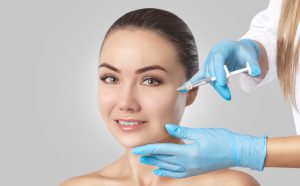Botox, Dysport, Xeomin, and Jeuveau belong to a category of cosmetic injectables called neuromodulators. While the specific formulations of these injectables may differ slightly, their primary component is a neurotoxin protein called botulinum toxin. When injected into targeted regions, neuromodulators prevent the nerves from communicating with targeted muscles. As such, the targeted muscle is temporarily paralyzed, incapable of performing its functions.
Botox is most popularly used as a cosmetic injectable to minimize the appearance of dynamic wrinkles, i.e., the wrinkles produced by the overuse of facial muscles. However, neuromodulators also serve medical purposes that reach far beyond cosmetic injections. They’re also used to treat excessive sweating, migraines, severe headaches, and various other conditions. Below, we discuss the various treatment areas for neuromodulators.
Cosmetic Botox Treatment Areas
- Forehead: Neuromodulators smoothen the horizontal forehead lines or “surprise lines” that appear when you raise your eyebrows.
- Between the Eyebrows: Neuromodulators smoothen the vertical lines or “frown lines” that appear between the eyebrows when you frown or concentrate.
- Around the Nose: Neuromodulators minimize the crinkles or wrinkles, also known as “bunny lines,” that surround the nose when you scrunch your nose up to smell something.
- Eyebrows: Aging can make your upper eyelids droop down or hood over your eyes. Neuromodulators, when strategically injected around the eyes, can counteract the horizontal hooding of the eyelids to lift them into a natural position.
- Around the Eyes: Neuromodulators smoothen the wrinkles or “crow’s feet” that appear around your eyes due to age.
- Tear Trough: Neuromodulators smoothen the fine lines or wrinkles that appear just under the lower eyelids or “tear trough.”
- Around the Mouth: Neuromodulators smoothen the fine lines or “lipstick lines” that appear around your mouth as you grow older.
- Chin: As we age, the mentalis muscles in our chin start flexing more than they should, leading to a “cobblestone” appearance. Neuromodulators smoothen the dimpled and puckered appearance.
- Neck: The loss of collagen, gravitational pull, and overworked facial muscles lead to vertical bands and horizontal lines on the neck. Neuromodulators can be delivered around the neck to smoothen the neckbands.
Medical Botox Uses
- TMJ: The temporomandibular joint (TMJ) connects the jawbone to the rest of the face, facilitating all jaw-related movements, such as laughing, chewing, talking, etc. TMJ disorders due to excessive teeth grinding can be relieved with Botox injections.
- Migraines: If you get chronic headaches, Botox injections can be delivered to the nose, temples, forehead, back of the head, or other targeted areas to relieve the headaches.
- Hyperhidrosis: Overactive sweat glands lead to excessive sweating even when there’s no physical or external stimulus for sweating. However, Botox and neuromodulators temporarily paralyze the overactive sweat glands to prevent excessive sweating. The injections may be delivered to the region with excessive sweating.
- Urinary Incontinence: Botox and neuromodulators can also relax the bladder muscles leading to urinary incontinence or an overactive bladder.
Neuromodulators are incredibly effective and beneficial treatments, and research about their potential uses is ongoing. If you have any of the aforementioned concerns, please schedule a consultation with Dr. Richard Montilla to discuss your Botox treatment options.


